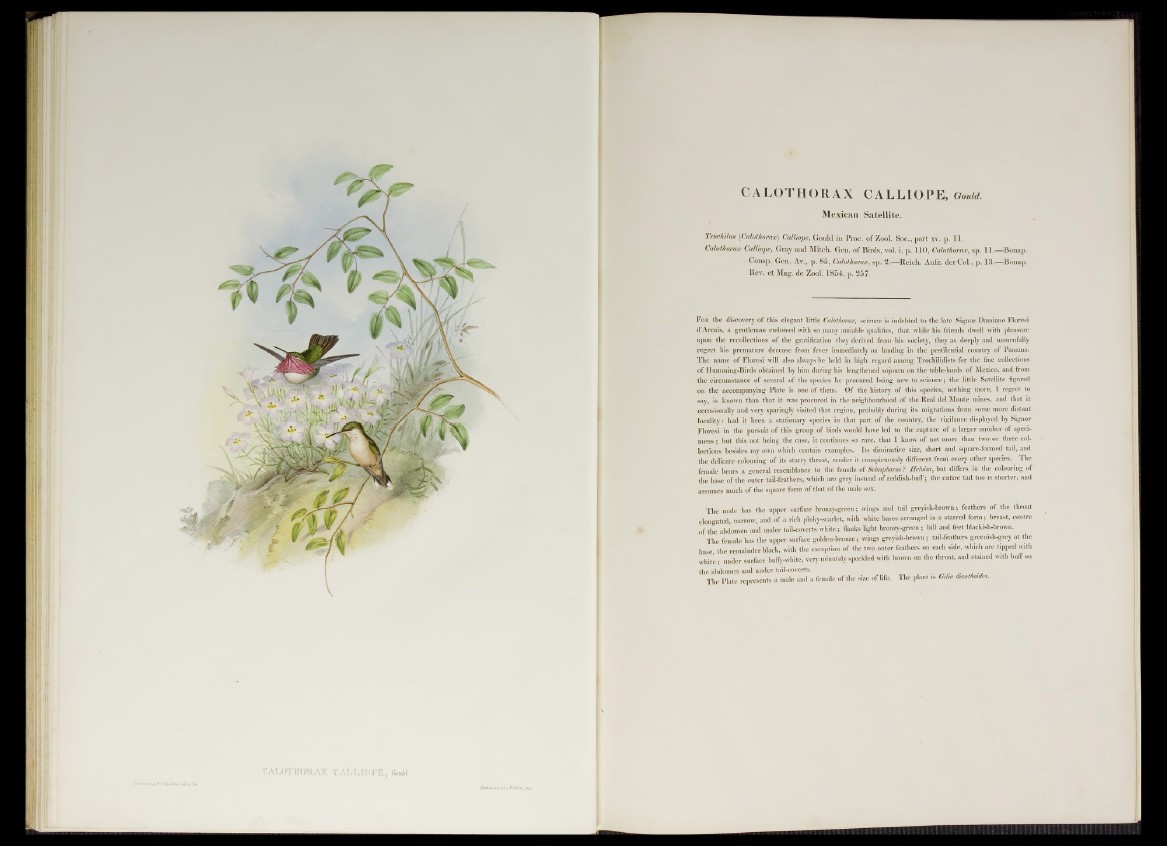
CALOTHORAX CALLIOPE, Gould.
Mexican Satellite.
Trochiltis (Calothorax) Calliope, Gould in Proc. of Zool. Soc., part xv. p. 11.
Calothorax Calliope, Gray and Mitch. Gen. of Birds, vol. i. p. 110, Calothorax, sp. 11.—Bonap.
Consp. Gen. Av., p. 85, Calothorax, sp. 2.—Reich. Aiifz. der Col., p. 13.—Bonap.
Rev. et Mag. de Zool. 1854, p. 257.
F or the discovery of this elegant little Calothorax, science is indebted to the late Signor Damiano Floresi
d’Areais, a gentleman endowed with so many amiable qualities, that while his friends dwell with pleasure
upon the recollections of the gratification they derived from his society, they as deeply and mournfully
regret his premature decease from fever immediately on landing in the pestilential country of Panama.
The name of Floresi will also always be held in high regard among Trochilidists for the fine collections
of Humming-Birds obtained by him during his lengthened sojourn on the table-lands of Mexico, and from
the circumstance of several of the species he procured being new to science; the little Satellite figured
on the accompanying Plate is one of them. Of the history of this species, nothing more, I regret to
say, is known than that it was procured in the neighbourhood of the Real del Monte mines, and that it
occasionally and very sparingly visited that region, probably during its migrations from some more distant
locality: had it been a stationary species in that part of the country, the vigilance displayed by Signor
Floresi in the pursuit of this group of birds would have led to the capture of a larger number of specimens
; but this not being the case, it continues so rare, that I know of not more than two or three collections
besides my own which contain examples. Its diminutive size, short and square-formed tail, and
the delicate colouring of its starry throat, render it conspicuously different from every other species. The
female bears a general resemblance to the female of Selaspkorus ? Heloisa, but differs in the colouring of
the base of the outer tail-feathers, which are grey instead of reddish-buff; the entire tail too is shorter, and
assumes much of the square form of that of the male sex.
The male has the upper surface bronzy-green; wings and tail greyish-brown; feathers of the throat
elongated, narrow, and of a rich pinky-scarlet, with white bases arranged in a starred form; breast, centre
of the abdomen and under tail-coverts white; flanks light bronzy-green ; bill and feet blackish-brown.
The female has the upper surface golden-bronze; wings greyish-brown; tail-feathers greenish-grey at the
base the remainder black, with the exception of the two outer feathers on each side, which are tipped with
hite • under surface buffy-white, very minutely speckled with brown on the throat, and stained with buff on
nltd ivi mi finii 11 llil P I »m m